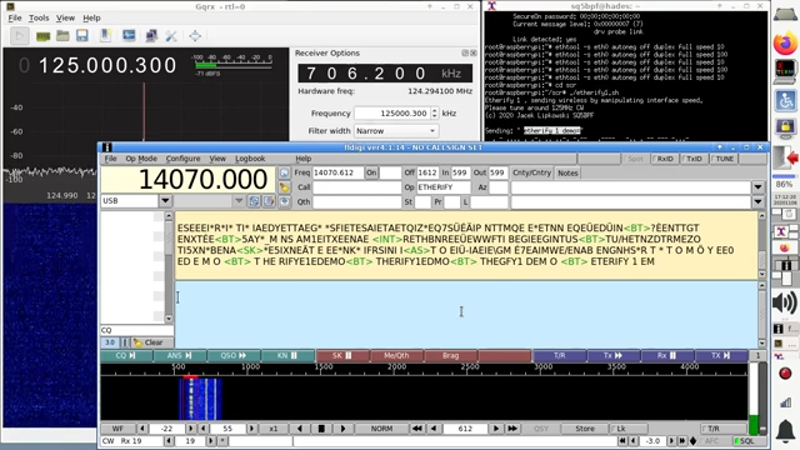Since the ether is an old term for the fictitious space where radio waves propagate, we always thought it was strange that the term ethernet refers to wired communication. Sure, there are wireless devices, but that’s not really ethernet. [Jacek] had the same thought, but decided to do something about it.
What he did is use two different techniques to alter the electromagnetic emission from an ethernet adapter on a Raspberry Pi. The different conditions send Morse code that you can receive at 125 MHz with a suitable receiver.
Practical? Hardly, unless you are looking to exfiltrate data from an air-gapped machine, perhaps. But it does have a certain cool factor. The first method switches the adapter between 10 Mbps and 100 Mbps. The second technique uses a stream of data to accomplish the modulation. The switching method had a range of around 100 meters while the data-based method topped out at about 30 meters. The code is on GitHub if you want to replicate the experiment.
There is plenty of precedent for this sort of thing. In 1976 Dr. Dobb’s Journal published an article about playing music on an Altair 8800 by running code while an AM radio was nearby. We’ve seen VGA adapters forced to transmit data, too.















This is very interesting because a version could apply to any port, so it might be possible to physically trace the path packets take through a network.
SORRY I SAID ANYTHING!! PLEASE DON’T BAN ETHERNET JUST ON THE OFF CHANCE SOMEONE CAN GLEAN SOME VAUGE INFO!
Makes me wonder if the same trick would work on, say, cisco switches/routers with a tcl script for changing the speed of transmission? That’s only technical curiosity, as obviously once once has the admin access to force this type of action they have already got all the access they need.
When Robert Metcalfe created Ethernet, he was inspired by the University of Hawaii ALOHAnet, which did use radio. He envisioned Ethernet as radio over cable.
https://en.wikipedia.org/wiki/ALOHAnet
For those who’ve not come across this before,
https://en.m.wikipedia.org/wiki/Tempest_(codename)
125MHz? Slap bang in the middle of the VHF airband? Genius.
not that he had much choice, 125 is the frequency used by the ethernet hardware
At 100m range with a directional antenna, ground warnings will probably interfere more than the picked up transmissions.
Yep, that’s why twisted pair is used, to prevent interference. A lot of things used frequencies that are used for over the air communications. For example, cable TV networks added channels, by using frequencies that were used for other services. As a result, the cable companies had to continually work to prevent leaks.
It isn’t transmitting a signal with any appreciable distance. This is just a trick with electromagnetic interference by switching the data frequency. There’s no way to increase, or hack, the output strength to make it useful for anything outside a room.
Useless and old..
Nothing about taking something wireless like a ESP32 and removing it from from and making it private and wired.
https://hackaday.com/2005/12/25/tempest-for-eliza/
Personally, running a grey code addressing for a chip interconnect creating a multi core scalable cluster would have been better. Less invasive tech and less use of wireless signals already. Okay?
Lets not forget that “ether” was also an inhaled anesthetic many years ago used in an operating room or MASH unit to put people to sleep prior to surgery.
I think the original word that was supposed to be used here was “aether”
Either way…
Well that is one way to find the router you lost in the server room… A digital fox hunt.